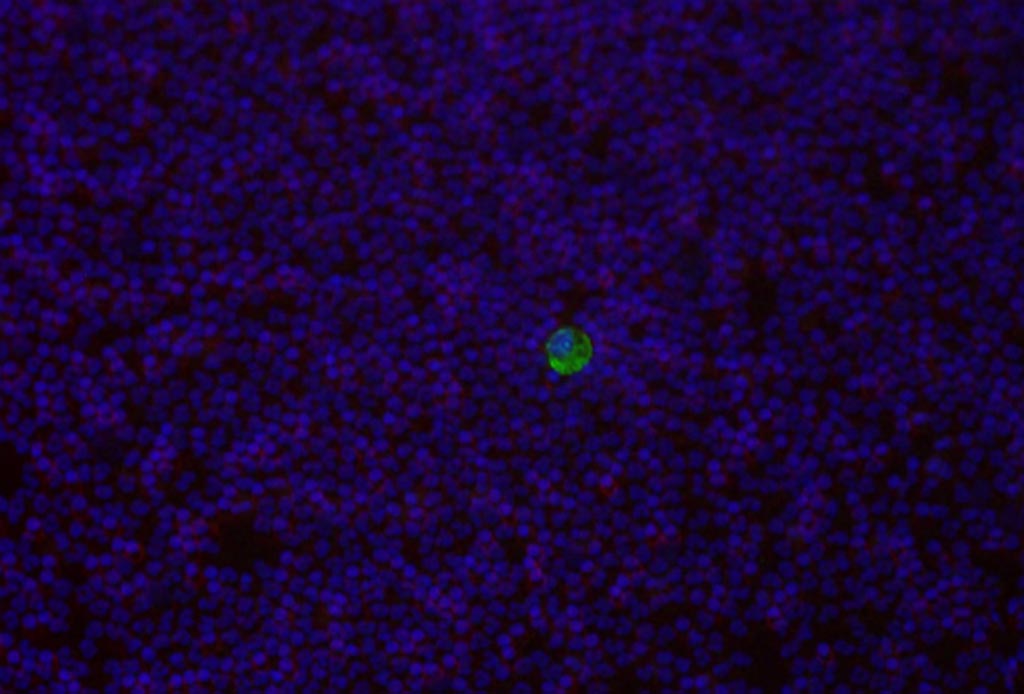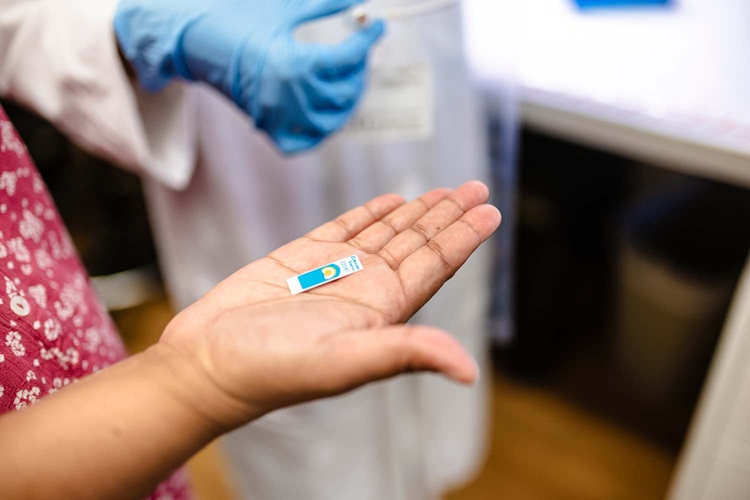Study Describes Use of Malaria Parasite Protein to Collect CTCs
|
By LabMedica International staff writers Posted on 30 Aug 2018 |

Image: A cancer cell colored with VAR2CSA (green) in a background of normal, white blood cells (red) (Photo courtesy of the University of Copenhagen Faculty of Health and Medical Sciences).
A novel technique uses the malaria parasite protein VAR2CSA to bind circulating tumor cells (CTCs) from a wide variety of cancer types for collection and analysis.
VAR2CSA (Variant Surface antigen 2-CSA), which binds specifically to the cancer cell membrane carbohydrate oncofetal chondroitin sulfate (ofCS), belongs to the Plasmodium falciparum erythrocyte membrane protein 1 (PfEMP1) family.
Isolation of metastatic CTCs from cancer patients is of high value for disease monitoring and molecular characterization. Despite the development of many new CTC isolation platforms in the last decade, their isolation and detection has remained a challenge due to the lack of specific and sensitive markers.
In a feasibility study published in the August 16, 2018, online edition of the journal Nature Communications, investigators at the University of Copenhagen Faculty of Health and Medical Sciences (Denmark) presented a method for CTC isolation based on the specific binding of the malaria VAR2CSA protein to the tumor marker ofCS.
The investigators reported that VAR2CSA captured CTCs efficiently from hepatic, lung, pancreatic, and prostate cancer patients with minimal contamination of peripheral blood mononuclear cells. Furthermore, in 25 stage I–IV prostate cancer patient samples, CTC enumeration significantly correlated with disease stage.
"We have developed a method where we take a blood sample and with great sensitivity and specificity, we are able to retrieve the individual cancer cells from the blood. We catch the cancer cells in greater numbers than existing methods, which offers the opportunity to detect cancer earlier and thus improve outcome. You can use this method to diagnose broadly, as it is not dependent on cancer type. We have already detected various types of cancer cells in blood samples. And if there is a cancer cell in your blood, you have a tumor somewhere in your body," said senior author Dr. Ali Salanti, professor of immunology and microbiology at the University of Copenhagen Faculty of Health and Medical Sciences.
"Today, it is difficult to determine which stage cancer is at. Our method has enabled us to detect cancer at stages one, two, three and four. Based on the number of circulating tumor cells we find in someone's blood, we will be able to determine whether it is a relatively aggressive cancer or not so then to adjust the treatment accordingly," said Dr. Salanti.
Related Links:
University of Copenhagen Faculty of Health and Medical Sciences
VAR2CSA (Variant Surface antigen 2-CSA), which binds specifically to the cancer cell membrane carbohydrate oncofetal chondroitin sulfate (ofCS), belongs to the Plasmodium falciparum erythrocyte membrane protein 1 (PfEMP1) family.
Isolation of metastatic CTCs from cancer patients is of high value for disease monitoring and molecular characterization. Despite the development of many new CTC isolation platforms in the last decade, their isolation and detection has remained a challenge due to the lack of specific and sensitive markers.
In a feasibility study published in the August 16, 2018, online edition of the journal Nature Communications, investigators at the University of Copenhagen Faculty of Health and Medical Sciences (Denmark) presented a method for CTC isolation based on the specific binding of the malaria VAR2CSA protein to the tumor marker ofCS.
The investigators reported that VAR2CSA captured CTCs efficiently from hepatic, lung, pancreatic, and prostate cancer patients with minimal contamination of peripheral blood mononuclear cells. Furthermore, in 25 stage I–IV prostate cancer patient samples, CTC enumeration significantly correlated with disease stage.
"We have developed a method where we take a blood sample and with great sensitivity and specificity, we are able to retrieve the individual cancer cells from the blood. We catch the cancer cells in greater numbers than existing methods, which offers the opportunity to detect cancer earlier and thus improve outcome. You can use this method to diagnose broadly, as it is not dependent on cancer type. We have already detected various types of cancer cells in blood samples. And if there is a cancer cell in your blood, you have a tumor somewhere in your body," said senior author Dr. Ali Salanti, professor of immunology and microbiology at the University of Copenhagen Faculty of Health and Medical Sciences.
"Today, it is difficult to determine which stage cancer is at. Our method has enabled us to detect cancer at stages one, two, three and four. Based on the number of circulating tumor cells we find in someone's blood, we will be able to determine whether it is a relatively aggressive cancer or not so then to adjust the treatment accordingly," said Dr. Salanti.
Related Links:
University of Copenhagen Faculty of Health and Medical Sciences
Latest BioResearch News
- Genome Analysis Predicts Likelihood of Neurodisability in Oxygen-Deprived Newborns
- Gene Panel Predicts Disease Progession for Patients with B-cell Lymphoma
- New Method Simplifies Preparation of Tumor Genomic DNA Libraries
- New Tool Developed for Diagnosis of Chronic HBV Infection
- Panel of Genetic Loci Accurately Predicts Risk of Developing Gout
- Disrupted TGFB Signaling Linked to Increased Cancer-Related Bacteria
- Gene Fusion Protein Proposed as Prostate Cancer Biomarker
- NIV Test to Diagnose and Monitor Vascular Complications in Diabetes
- Semen Exosome MicroRNA Proves Biomarker for Prostate Cancer
- Genetic Loci Link Plasma Lipid Levels to CVD Risk
- Newly Identified Gene Network Aids in Early Diagnosis of Autism Spectrum Disorder
- Link Confirmed between Living in Poverty and Developing Diseases
- Genomic Study Identifies Kidney Disease Loci in Type I Diabetes Patients
- Liquid Biopsy More Effective for Analyzing Tumor Drug Resistance Mutations
- New Liquid Biopsy Assay Reveals Host-Pathogen Interactions
- Method Developed for Enriching Trophoblast Population in Samples
Channels
Clinical Chemistry
view channel
POC Breath Diagnostic System to Detect Pneumonia-Causing Pathogens
Pseudomonas aeruginosa is a major cause of hospital-acquired and ventilator-associated pneumonia, particularly in lung transplant recipients and patients with structural lung disease. Its ability to form... Read more
Online Tool Detects Drug Exposure Directly from Patient Samples
Doctors often rely on patient interviews and medical records to determine what medications a person has taken, but this information is frequently incomplete. People may forget drugs they used, take over-the-counter... Read moreMolecular Diagnostics
view channel
STI Molecular Test Delivers Rapid POC Results for Treatment Guidance
An affordable, rapid molecular diagnostic for sexually transmitted infections (STIs) has the potential to be globally relevant, particularly in resource-limited settings where rapid, point-of-care results... Read more
Blood Biomarker Improves Early Brain Injury Prognosis After Cardiac Arrest
After a cardiac arrest, many patients remain unconscious for days, leaving doctors and families facing uncertainty about whether meaningful recovery is possible. Current tools to assess brain damage, including... Read more
Biomarkers Could Identify Patients at High Risk of Severe AKI After Major Surgery
Acute kidney injury is one of the most common and dangerous complications after major surgery, particularly among patients in intensive care. Even mild impairment of kidney function can lead to long-term... Read more
CLIA Test Identifies Head and Neck Cancer Recurrence from Post-Surgical Lymphatic Fluid
While the lymphatic system’s critical role in metastasis has long been recognized, routine access to patient lymph has been elusive. Now, a non-invasive process can access lymph through the collection... Read moreHematology
view channel
MRD Tests Could Predict Survival in Leukemia Patients
Acute myeloid leukemia is an aggressive blood cancer that disrupts normal blood cell production and often relapses even after intensive treatment. Clinicians currently lack early, reliable markers to predict... Read more
Platelet Activity Blood Test in Middle Age Could Identify Early Alzheimer’s Risk
Early detection of Alzheimer’s disease remains one of the biggest unmet needs in neurology, particularly because the biological changes underlying the disorder begin decades before memory symptoms appear.... Read more
Microvesicles Measurement Could Detect Vascular Injury in Sickle Cell Disease Patients
Assessing disease severity in sickle cell disease (SCD) remains challenging, especially when trying to predict hemolysis, vascular injury, and risk of complications such as vaso-occlusive crises.... Read more
ADLM’s New Coagulation Testing Guidance to Improve Care for Patients on Blood Thinners
Direct oral anticoagulants (DOACs) are one of the most common types of blood thinners. Patients take them to prevent a host of complications that could arise from blood clotting, including stroke, deep... Read moreImmunology
view channel
Blood Test Could Identify Colon Cancer Patients to Benefit from NSAIDs
Colon cancer remains a major cause of cancer-related illness, with many patients facing relapse even after surgery and chemotherapy. Up to 40% of people with stage III disease experience recurrence, highlighting... Read moreBlood Test Could Detect Adverse Immunotherapy Effects
Immune checkpoint inhibitors have transformed cancer treatment, but they can also trigger serious immune-related adverse events that damage healthy organs and may become life-threatening if not detected early.... Read moreMicrobiology
view channel
Breakthroughs in Microbial Analysis to Enhance Disease Prediction
Microorganisms shape human health, ecosystems, and the planet’s climate, yet identifying them and understanding how they are related remains a major scientific challenge. Even with modern DNA sequencing,... Read more
Blood-Based Diagnostic Method Could Identify Pediatric LRTIs
Lower-respiratory tract infections (LRTIs) are a leading cause of illness and death worldwide, and pneumonia is the leading infectious cause of death in children under five, claiming the lives of over... Read morePathology
view channel
Rapid Low-Cost Tests Can Prevent Child Deaths from Contaminated Medicinal Syrups
Medicinal syrups contaminated with toxic chemicals have caused the deaths of hundreds of children worldwide, exposing a critical gap in how these products are tested before reaching patients.... Read more
Tumor Signals in Saliva and Blood Enable Non-Invasive Monitoring of Head and Neck Cancer
Head and neck cancers are among the most aggressive malignancies worldwide, with nearly 900,000 new cases diagnosed each year. Monitoring these cancers for recurrence or relapse typically relies on tissue... Read more
Common Health Issues Can Influence New Blood Tests for Alzheimer’s Disease
Blood-based tests for Alzheimer’s disease are transforming diagnosis by offering a simpler alternative to spinal taps and brain imaging. However, many people evaluated at memory clinics also live with... Read more
Blood Test Formula Identifies Chronic Liver Disease Patients with Higher Cancer Risk
Chronic liver disease affects millions worldwide and can progress silently to hepatocellular carcinoma (HCC), one of the deadliest cancers globally. While surveillance guidelines exist for patients with... Read moreTechnology
view channel
Machine Learning Models Diagnose ALS Earlier Through Blood Biomarkers
Amyotrophic lateral sclerosis (ALS) is a rapidly progressive neurodegenerative disease that is notoriously difficult to diagnose in its early stages. Early symptoms often overlap with other neurological... Read more
Artificial Intelligence Model Could Accelerate Rare Disease Diagnosis
Identifying which genetic variants actually cause disease remains one of the biggest challenges in genomic medicine. Each person carries tens of thousands of DNA changes, yet only a few meaningfully alter... Read moreIndustry
view channel
BD and Penn Institute Collaborate to Advance Immunotherapy through Flow Cytometry
BD (Becton, Dickinson and Company, Franklin Lakes, NJ, USA) has entered into a strategic collaboration with the Institute for Immunology and Immune Health (I3H, Philadelphia, PA, USA) at the University... Read more




















